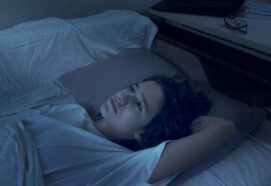Short summary
We know that there is a bidirectional association between sleep duration/quality and depressive symptoms in youth. In adult populations depressive symptoms and circadian rhythms (sleep chronotype) have also been linked. In this paper, we established an association between chronotype and depressive symptoms in middle adolescence, independently of poor sleep and prior mental health difficulties.
Background
The importance of good quality sleep cannot be underestimated, and the impact of poor sleep (i.e., sub-optimal duration, disruption in the form of night awakenings, and delayed onset of sleep after going to bed) on paediatric health (both physical and mental) has been the subject of substantial research in recent years. For instance, a special issue in JCPP (2020) contained—among other illuminating articles—a crucial contribution by Faith Orchard and collaborators (Orchard, et al., 2020), which used a sample of around 5,000 adolescents from the Avon Longitudinal Study of Parents and Children, providing evidence that sleep disturbances are linked with both concurrent and future anxiety and depression. Other work has provided evidence of associations between an ‘evening’ chronotype (i.e., a partially biologically driven preference, due to the body’s ‘internal clock’, to sleep later rather than earlier) and depressive symptoms in adolescence. However, such studies have typically been limited by smaller sample sizes, and they have not always considered the effects of potential confounders, including the central issue of sleep quality.
The present study
In our study (Tsomokos, Halstead, & Flouri, 2024), we relied on a large sample of over 11,300 teenagers (aged around 14 years) from the Millennium Cohort Study. Depressive symptoms were measured through the well-validated Short Mood and Feelings Questionnaire (MFQ) with 13 self-report items (e.g., “I felt miserable or unhappy” and “I thought I could never be as good as other kids”).
As a proxy of chronotype we used a few measures, including the established measure of the mid-point of sleep on non-school nights (i.e., Friday/Saturday) , that is, the approximate time that falls in the middle between falling asleep (i.e., on a Friday night) and waking up (i.e., on a Saturday), see for example Lemke et al. (2023). We also used the simpler measure of the approximate time (falling within an hour slot) of falling asleep on school nights. Reassuringly, these two measures were highly correlated, which implies that simply asking teenagers approximately what time they go to bed on a school night (and fall asleep in, say, crude hour slots, such as 8pm-9pm, or 9pm-10pm, and so on), is a good measure of their chronotype.
The study was highly powered, so we were able to account for a wide range of potential confounders in a robust way, careful not to introduce bias . Using an ecological framework, we considered socioeconomic factors, area deprivation, safety and air pollution, maternal mental health, the cohort member’s cognitive ability, quality of decision-making and tendency to take risks, diet and screen time, BMI, chronic illness, physical activity and alcohol intake, the presence of special educational needs, the frequency of family meals, and whether the adolescent had recently moved schools or had been the victim of peer bullying. Most importantly, however, we also accounted for poor sleep (duration, sleep latency, and night awakenings), as well as prior mental health problems (at age 11 years).
Impact & recommendations
The result of our analysis was a very robust association between chronotype and depressive symptoms at age 14, after controlling for prior mental health difficulties (at age 11), poor sleep, and a range of other confounders. Using the sleep midpoint on non-school nights, for every 1-2 hours of later sleep time (more ‘eveningness’) there was an additional symptom of depression, or a higher intensity of an existing symptom, as measured by the (maximum of) thirteen items in the short MFQ scale. Further, the association was moderated by biological sex, and females were more susceptible to a shift towards an ‘evening’ chronotype compared to males. These results were based on well-powered, cross-sectional, multiple regression analyses (both with and without interaction effects between biological sex and chronotype), which were performed in a way that ensured we did not introduce bias due to the large number of confounders. It should be noted that this data (from the 6th wave of the Millennium Cohort Study) was collected before the pandemic, in 2015-2016.
In practice, sleep is not a unidimensional factor, and it is crucial to consider chronotype alongside sleep duration and sleep quality. On the basis of our study, it appears that asking adolescents what time they fall asleep on a typical school night is a valid proxy of chronotype. Assuming that their sleep hygiene is good, sleeping later rather than earlier is associated with a higher risk of depressive symptoms at age 14. However, the limitations of our study—most notably, the fact that there were no objective measures of sleep, or clinical assessment of psychopathology, as well as the inherently correlational nature of the analysis—mean that a lot more work needs to be done in this age group to better understand these associations and potential causal directions.
Conclusion
Adolescents (around 14 years old) with an evening chronotype reported a higher number of depressive symptoms, and eveningness was more strongly associated with depressive symptoms in females. The simplest way of measuring chronotype in this age group may be asking adolescents what time they typically go to bed and fall asleep on a school night.
NB this blog has been peer-reviewed
Conflicts of interest
Dr. Dimitris Tsomokos was involved in this study as a researcher and first author.
References
- JCPP (2020), Special Issue: Waking Up to the Importance of Sleep for Child & Adolescent Mental Health & Disorders. J Child Psychol Psychiatr, 61: i-iv. https://doi.org/10.1111/jcpp.13334
- Orchard, F., Gregory, A.M., Gradisar, M. and Reynolds, S. (2020), Self-reported sleep patterns and quality amongst adolescents: cross-sectional and prospective associations with anxiety and depression. J Child Psychol Psychiatr, 61: 1126-1137. https://doi.org/10.1111/jcpp.13288
- Lemke, T., Hökby, S., Wasserman, D., Carli, V., & Hadlaczky, G. (2023). Associations between sleep habits, quality, chronotype and depression in a large cross-sectional sample of Swedish adolescents. PloS one, 18(11), e0293580. https://doi.org/10.1371/journal.pone.0293580
- Tsomokos, D. I., Halstead, E., & Flouri, E. (2024). Chronotype and depression in adolescence: Results from a UK birth cohort study. JCPP Advances, e12245. https://doi.org/10.1002/jcv2.12245


